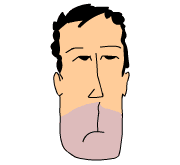Perusers of BibleDudes, archaeology is the study of arches, and the three most important arches pertaining to the Bible are as follows: Titus' arch in Rome, L'arc de Triumph in Paris, and my personal favorite, that big metal one in St. Louis. These of course all go back to the Romans and the letter M.
![[Methuselah]](../images/meth/arches_1_bottom.gif)

Ugh! Actually, archaeology involves dirt and adventure, but most of all, archaeology is the scientific examination of material remains from humans in the past. And when archaeology is applied to the lands where biblical stories were set, this often involves a "Tell" (in Arabic) or "Tel" (in Hebrew), both words meaning "small mound." We asked one of our favorite small mounds, Tel Megiddo, to explain further.
![[Tel Megiddo]](../images/other/tel_1_left.gif)
What is up, BibleDudes? You know, like all archaeological tells, I'm a mound that was formed by successive periods of human occupation. Some novices confuse me with a naturally formed hill, but a trained eye can easily tell the difference. Each time somebody lived on me, the remains of their civilization, such as mudbrick houses, ceramics, and city walls, got piled on top of the previous layers. One of these layers of occupation is called a stratum, or strata in the plural. The most recent stratigraphical layer is on my surface, and I'd be just fine if those meddling archaeologists wouldn't... Aaaaghghhhh! Is that a trowel?!?
![[Trowel]](../images/other/trowel_1_right.gif)
Right you are, my old nemesis Mr. Tell! I am a trowel, the basic tool of the archaeologist. I am used, along with brushes, picks, shovels, and in some cases even bulldozers, to remove strata in order to understand the entire history of a site. Thus archaeology has been called a destructive science, because things can only be uncovered once. That is why it is so important for archaeologists to keep detailed records and to publish their finds.

Speaking of records, dears, I wanted to explain briefly how archaeologists record their finds. Typically they divide a tell into areas that they will be excavating. Within these areas, they map out 5x5 meter squares on the surface. The next step involves assigning locus numbers. Locus is Latin for "place," and it is any identifiable earthen layer or human-made feature, such as a wall, fill between walls, or a floor. So even the surface of a square is given a locus number, and then when excavators start peeling layers back, they assign new numbers for loci as they go. When artifacts such as a pottery shard are uncovered in a locus, these finds are given a basket number, which is typically the most specific designation for a find. So when recording on an archaeological dig, my darlings, from general to specific it is as follows:
site
area
square
locus
basket
Right on! We've invited three famous archaeologists to help explain archaeology and the Bible.

![[Belloq]](../images/other/belloq_1_left.gif)
Archaeology is our religion, yet we have both fallen from the pure faith. Our methods have not differed as much as you pretend. I am but a shadowy reflection of you. It would take only a nudge to make you like me, to push you out of the light.
![[Indiana Jones]](../images/other/indiana_1_right.gif)
Shut up Belloq. I think the BibleDudes invited Petrie, Kenyon, and Albright, three of the greatest names associated with archaeology in the Holy Land.
![[Petrie]](../images/other/petrie_1_left.gif)
Cheerio BibleDudes. I've been called the inventor of modern scientific archaeology, as people before me perhaps would more accurately be called "treasure hunters." While I excavated many sites in the late 19th century, including Tanis and the Great Pyramid of Giza, I'm most famous for the six weeks I spent in 1890 at Tell el-Hesi in Palestine. For the first time, I correlated everyday artifacts, such as pottery, with stratigraphical layers. Because of this and further comparisons after my work, archaeologists can now look at a jar handle or a rim and know fairly accurately to what century that stratum dates. Brilliant scholars such as William Albright took this idea of pottery serration even further.
![[Albright]](../images/other/albright_1_right.gif)
That is very kind of you Flinders. I became an expert in Semitic languages and ancient Near Eastern history, and decided to combine this knowledge with the emerging discipline of scientific archaeology. My most famous excavation was at Tell Beit Mirsim in the 1920s and 30s. I thoroughly analyzed my finds, and the four volumes of final reports that I published provided a typology of ceramic forms that was seminal for many years. But more than that, it was the vast number of students that I trained, both in history and archaeology, that had the greatest impact on the field. Today, when people speak of biblical archaeology, and even biblical studies in general, my name comes up most often. Dame Kenyon, wouldn't you agree?
![[Kenyon]](../images/other/kenyon_1_left.gif)
Yes, Dr. Albright, especially when we speak of the discipline in North America. But in Britain, and even world wide, I had a pretty immense impact on archaeology myself. I excavated Jericho in the 1950s and brought a completely new method of excavating to the region. Typically before me, archaeologists would find walls and dig out the entire room, thus exposing a broad horizontal area. Instead, I preferred to dig narrow trenches to show in detail the relationship between strata. While few archaeologists today solely rely on trenches, most archaeologists use a combination of the horizontal method and the vertical method I helped to develop. They do this with balks, vertical sections of strata left unexcavated. Archaeologists leave the sides of a 5x5 m square untouched, and thus achieve horizontal exposure inside the square, while on the outside perimeter, the balks preserve the stratigraphical record.
Dude! Like click on this trowel to EXCAVATE a Tel with this interactive Flash thingamajig called "Stratigraphical Layers In The Southern Levant." Rock on!
![]()
![[Mike]](../images/mike/glassesup_1_right.gif)
Yo! I want to take a moment and talk about how biblical archaeology got to be a bad rap. Early biblical archaeologists went to the Holy Land to prove that specific events recorded in the Bible were true. This failed in the end. However, archaeology has been great at providing background to biblical stories. For example, archaeology will never prove that Abraham married Sarah, or that God made a covenant with Moses, or that Jesus was resurrected. But it does show what the horned altars referred to in the Bible looked like, what Egypt was like around the time of Moses, and what life was like in Jerusalem during Jesus' time. Consequently, the Bible can be very valuable tool for the archaeologists in the Holy Land, and vice versa.
![[Jeff]](../images/jeff/talking_1_left.gif)
Below we put together some of the most important archaeological discoveries pertaining to biblical studies. Click on the image to read a description.
| Merneptah Stele | Tel Dan Stele | Shalmaneser III's Black Obelisk |
| Moabite Stone | Gilgamesh Tablet XI | Pilate Inscription |
| Nag Hammadi Texts | James Ossuary | Jehoash Inscription |
| Ketif Hinnom Inscription | Dead Sea Scrolls | Solomonic Gates |
| Caiaphas Ossuary | Ugaritic Texts | Sennacherib Prism |
| Siloam Inscription | Lachish Reliefs | Lachish Letters |
![[Mike]](../images/mike/book_1_left.gif)
Fascinating dude! Soon, after we write the next section, you'll be able to examine how Literary Criticism arose and how it impacted biblical studies. Yes way!